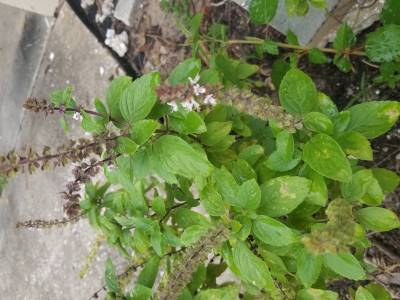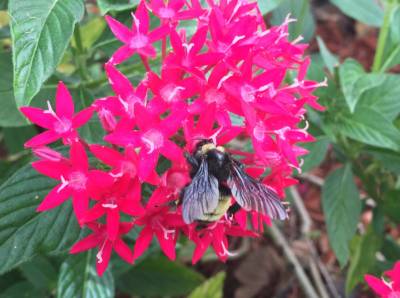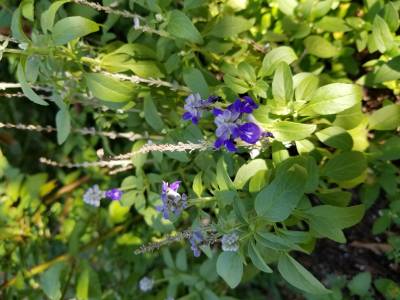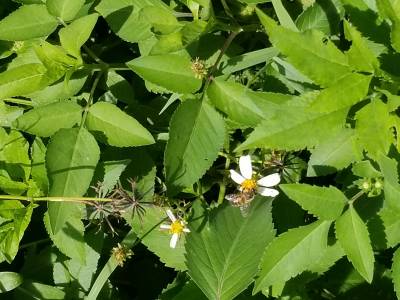User Tools
This is an old revision of the document!
Table of Contents
Bee Friendly Plants in Central Florida
African Blue Basil
Ocimum kilimandscharicum X Ocimum basilicum
This herb is perfect for anyone not wanting to encourage the growth of weeds in their yard or garden. African blue basil is a hybrid between camphor basil and dark opal basil that does not produce viable seeds. These plants are propagated through cutting, and will not take over the garden. The plants are relatively hardy and very aromatic. Many people are reluctant to allow their traditional varieties of basil to flower (although the bees would love them too), so bringing this gem into garden in addition can satisfy your pollinators while keeping your favorite variety of fresh basil for yourself.
Pentas/Egyptian Star Flower
Pentas lanceolata
Summer can be dearth (a time when there are limited pollen and nectar sources for bees to forage) for pollinators in central Florida. Adding colorful pentas to your garden can help see them through the lean months. The flowers bloom through the heat of the Florida summer in shades of white, pink, red, or purple. Here in the southern states they are perennials and will do well either in containers or in flower beds.
Pusley/Mexican Clover/Florida Snow
Richardia scabbra
Our next pollinator friendly plant is another “weed” common in central Florida. Pusley is a vining ground cover that produces tiny star-shaped white flowers. Grass or sod lawns are food deserts for honeybees, but when allowed to grow amongst the lawn these flowers can give them a helpful rest stop. This member of the coffee family can make a great grass substitute for anyone wanting a low maintenance lawn. It's low profile can reduce or eliminate the need for mowing. It also is drought tolerant and loves full sun and sandy soil. This plant does like to over take walkways and low profile garden edging, so be vigilant if there are areas where you don't want these vines encroaching.
Salvia
Salvia spp Pictured: Salvia farinacea
Salvias are another great plant to provide over summer forage for central Florida pollinators. They begin blooming in the spring and continue through summer into the fall. These perennial members of the mint family vary in size from 1 to 5 feet tall and come in a wide range of colors. They are heat and drought tolerant and enjoy full sun.
Spanish Needle/Tickseed/Pitchfork Weed
Bidens alba or Bidens pilosa.
Considered a weed by many in central Florida, these flowers are a favorite of honeybees, butterflies, and many native pollinators. They are prolific and produce stiff black seeds that stick to clothing, pets, and skin. But if you can stand to allocate a section of your yard or garden for these somewhat shrub-like plants, they will do a great deal for a variety of pollinators in your area. According to Green Deane, “In Florida B. alba is the third most common reliable source of nectar.” He continues, “The second most common nectar producer in Florida is the saw palmetto and the top producer is the non-native, citrus.” 1)
Tips for Planting for Pollinators
- Plant same/similar species in large groups. Although I have personally witnessed bees visit more than one type of flower on a single trip, they prefer to practice “floral constancy.” This means clusters of similar flowers will be more appealing. Basic recommendations are that lots should be approx. 3.5 ft x 3.5 ft or row equivalent.
- Plant trees. Trees are popular sources of pollinator food sources because of the floral constancy theory. Even trees that are not known for their flowers, such as palms and maples, are important pollen and nectar sources.
- Allow palms to bloom. Some people do not think that the scraggly flowers of some palm trees are attractive and so will discourage trees from flowering by removing the stalks. But palms are important pollen and nectar sources. You can cut the stalks once the blossoms are spent and they berries are starting to form. But if the flowers are left to open you will find your tree literally “abuzz” with several species of native bees as well as honeybees.
- Plant native species when possible. Some native pollinators will not be able to utilize exotic specimens. Some nonnative plants can also become invasive pests.
- Consider bloom schedules. Try to coordinate your garden so that you have some plants in bloom at any given time of year. Some times of the year are more challenging for pollinators than others. Planning for year round blooms helps negate some of the dearth severity.
- Be observant. Watch nature and she will inspire and guide you. Pay attention to landscaping at places you visit and look for pollinating activity. I personally, will wander around the garden section of home improvement stores and take note of which flowers and plants are receiving the most attention from the bees and bring some of those home with me.






